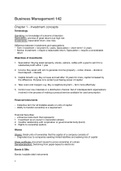Summary
Summary Business Management 142 notes
- Course
- Institution
I used all of the lectures as well as the notes we were given in class to summarise the semesters work for the whole module. These are well summarised and understandable notes, perfect for studying for A1, A2 or A3.
[Show more]



